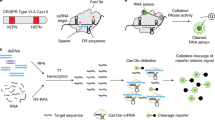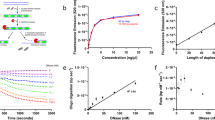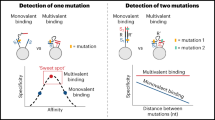Abstract
Small variations in nucleic acid sequences can have far-reaching phenotypic consequences. Reliably distinguishing closely related sequences is therefore important for research and clinical applications. Here, we demonstrate that conditionally fluorescent DNA probes are capable of distinguishing variations of a single base in a stretch of target DNA. These probes use a novel programmable mechanism in which each single nucleotide polymorphism generates two thermodynamically destabilizing mismatch bubbles rather than the single mismatch formed during typical hybridization-based assays. Up to a 12,000-fold excess of a target that contains a single nucleotide polymorphism is required to generate the same fluorescence as one equivalent of the intended target, and detection works reliably over a wide range of conditions. Using these probes we detected point mutations in a 198 base-pair subsequence of the Escherichia coli rpoB gene. That our probes are constructed from multiple oligonucleotides circumvents synthesis limitations and enables long continuous DNA sequences to be probed.
This is a preview of subscription content, access via your institution
Access options
Subscribe to this journal
Receive 12 print issues and online access
$259.00 per year
only $21.58 per issue
Buy this article
- Purchase on Springer Link
- Instant access to full article PDF
Prices may be subject to local taxes which are calculated during checkout





Similar content being viewed by others
References
Gunderson, K. L., Steemers, F. J., Lee, G., Mendoza, L. G. & Chee, M. S. A genome-wide scalable SNP genotyping assay using microarray technology. Nature Biotechnol. 37, 549–554 (2005).
Kim, S. & Misra A. SNP genotyping: technologies and biomedical applications. Annu. Rev. Biomed. Eng. 9, 289–320 (2007).
Arnold, C. et al. Single-nucleotide polymorphism-based differentiation and drug resistance detection in Mycobacterium tuberculosis from isolates or directly from sputum. Clin. Microbiol. Infect. 11, 122–130 (2005).
Bang, H. et al. Improved rapid molecular diagnosis of multidrug-resistant tuberculosis using a new reverse hybridization assay, REBA MTB-MDR. J. Med. Microbiol. 60, 1447–1454 (2011).
Schena, M., Shalon, D., Davis, R. W. & Brown, P. O. Quantitative monitoring of gene expression patterns with a complementary DNA microarray. Science 270, 467–470 (1995).
Saiki, R. K. et al. Primer-directed enzymatic amplification of DNA with a thermostable DNA polymerase. Science 239, 487–491 (1988).
Shendure, J. et al. Accurate multiplex polony sequencing of an evolved bacterial genome. Science 309, 1728–1732 (2005).
Landegren, U., Kaiser, R., Sanders, J. & Hood, L. A ligase-mediated gene detection technique. Science 241, 1077–1080 (1988).
Tong, A. K., Li, Z., Jones, G. S., Russo, J. J. & Ju, J. Combinatorial fluorescence energy transfer tags for multiplex biological assays. Nature Biotechnol. 19, 756–759 (2001).
Botstein, D., White, R. L., Skolnick, M. & Davis, R. W. Construction of a genetic linkage map in man using restriction fragment length polymorphisms. Am. J. Hum. Genet. 32, 314 (1980).
Hall, J. G. et al. Sensitive detection of DNA polymorphisms by the serial invasive signal amplification reaction. Proc. Natl Acad. Sci. USA 97, 8272–8277 (2000).
Xu, Y., Karalkar, N. B., & Kool, E. T. Nonenzymatic autoligation in direct three-color detection of RNA and DNA point mutations. Nature Biotechnol. 19, 148–152 (2001).
Grossmann, T. N. & Seitz, O. Nucleic acid templated reactions: consequences of probe reactivity and readout strategy for amplified signaling and sequence selectivity. Chem. Eur. J. 15, 6723–6730 (2009).
Singh, S. K., Koshkin, A. A., Wengel, J. & Nielsen, P. LNA (locked nucleic acids): synthesis and high-affinity nucleic acid recognition. Chem. Commun. 4, 455–456 (1998).
Egholm, M., Buchardt, O., Nielsen, P. E. & Berg, R. H. Peptide nucleic acids (PNA). Oligonucleotide analogs with an achiral peptide backbone. J. Am. Chem. Soc. 114, 1895–1897 (1992).
Simeonov, A. & Nikiforov, T. T. Single nucleotide polymorphism genotyping using short, fluorescently labeled locked nucleic acid (LNA) probes and fluorescence polarization detection. Nucleic Acids Res. 30, e91 (2002).
Komiyama, M. et al. PNA for one-base differentiating protection of DNA from nuclease and its use for SNPs detection. J. Am. Chem. Soc. 125, 3758–3762 (2003).
Tyagi, S. & Kramer, F. R. Molecular beacons: probes that upon hybridization. Nature Biotechnol. 14, 303–308 (1996).
Zhang, D. Y., Chen, S. X. & Yin, P. Optimizing the specificity of nucleic acid hybridization. Nature Chem. 4, 208–214 (2012).
Guo, Z., Liu, Q. & Smith, L. M. Enhanced discrimination of single nucleotide polymorphisms by artificial mismatch hybridization. Nature Biotechnol. 15, 331–335 (1997).
Zhang, D. Y. & Winfree, E. Control of DNA strand displacement kinetics using toehold exchange. J. Am. Chem. Soc. 131, 17303–17314 (2009).
Xiao, Y. et al. Fluorescence detection of single-nucleotide polymorphisms with a single, self-complementary, triple-stem DNA probe. Angew. Chem Int. Ed. 48, 4354–4358 (2009).
Tyagi, S. Imaging intracellular RNA distribution and dynamics in living cells. Nature Methods 6, 331–338 (2009).
Manganelli, R., Tyagi, S. & Smith, I. Real-time PCR using molecular beacons. Methods Mol. Med. 54, 295–310 (2001).
Severinov, K., Soushko, M., Goldfarb, A. & Nikiforov, V. Rifampicin region revisited. J. Biol. Chem. 268, 14820–14825 (1993).
Telenti, A. et al. Detection of rifampicin-resistance mutations in Mycobacterium tuberculosis. Lancet 341, 648–650 (1993).
Thompson, B. J., Camien, M. N. & Warner, R. C. Kinetics of branch migration in double-stranded DNA. Proc. Natl Acad. Sci. 73, 2299–2303 (1976).
Panyutin, I. G. & Hsieh, P. The kinetics of spontaneous DNA branch migration. Proc. Natl Acad. Sci. 91, 2021–2025 (1994).
Panyutin, I. G. & Hsieh, P. Formation of a single base mismatch impedes spontaneous DNA branch migration. J. Mol. Biol. 230, 413–424 (1993).
Zhang, D. Y. & Seelig, G. Dynamic DNA nanotechnology using strand displacement reactions. Nature Chem. 3, 103–114 (2011).
Seelig, G., Soloveichik, D., Zhang, D. Y. & Winfree, E. Enzyme-free nucleic acid logic circuits. Science 314, 1585–1588 (2006).
Zhang, D. Y., Turberfield, A. J., Yurke, B. & Winfree, E. Engineering entropy-driven reactions and networks catalyzed by DNA. Science 318, 1121–1125 (2007).
Soloveichik, D., Seelig, G. & Winfree, E. DNA as a universal substrate for chemical kinetics. Proc. Natl Acad. Sci. 107, 5393–5398 (2010).
Zhang, D. Y. & Winfree, E. Robustness and modularity properties of a non-covalent DNA catalytic reaction. Nucleic Acids Res. 38, 4182–4197 (2010).
Qian, L. & Winfree, E. Scaling up digital circuit computation with DNA strand displacement cascades. Science 332, 1196–1201 (2011).
Nandagopal, N. & Elowitz M. B. Synthetic biology: integrated gene circuits. Science 333, 1244–1248 (2011).
Purnick, P. E. M. & Weiss, R. The second wave of synthetic biology: from modules to systems. Nature Rev. Mol. Cell Biol. 10, 410–422 (2009).
Bunka, D. H. J., Platonova, O. & Stockley, P. G. Development of aptamer therapeutics. Curr. Opin. Pharmacol. 10, 557–562 (2010).
SantaLucia, J. & Hicks, D. The thermodynamics of DNA structural motifs. Annu. Rev. Biochem. 33, 415–440 (2004).
Marras, S. A., Kramer, F. R. & Tyagi, S. Efficiencies of resonance energy transfer and contact-mediated quenching in oligonucleotide probes. Nucleic Acids Res. 30, e122 (2002).
Biswas, I., Yamamoto, A. & Hsieh, P. Branch migration through DNA sequence heterology. J. Mol. Biol. 279, 795–806 (1998).
Lishanski, A. Screening for single-nucleotide polymorphisms using branch migration inhibition in PCR-amplified DNA. Clin. Chem. 46, 1464–1470 (2000).
Yang, Q. et al. Allele-specific Holliday junction formation: a new mechanism of allelic discrimination for SNP scoring. Genome Res. 13, 1754–1764 (2003).
Liu, Y. P., Behr, M. A., Small, P. M. & Kurn, N. Genotypic determination of Mycobacterium tuberculosis antibiotic resistance using a novel mutation detection method, the branch migration inhibition M. tuberculosis antibiotic resistance test. J. Clin. Microbiol. 38, 3656–3662 (2000).
McNerney, R. & Daley, P. Towards a point-of-care test for active tuberculosis: obstacles and opportunities. Nature Rev. Microbiol. 9, 204–213 (2011).
Niemz, A., Ferguson, T. M. & Boyle, D. S. Point-of-care nucleic acid testing for infectious diseases. Trends Biotechnol. 29, 240–250 (2011).
Piatek, A. S. et al. Molecular beacon sequence analysis for detecting drug resistance in Mycobacterium tuberculosis. Nature Biotechnol. 16, 359–363 (1998).
Boehme, C. C. et al. Rapid molecular detection of tuberculosis and rifampin resistance. N. Engl. J. Med. 363, 1005–1015 (2010).
Browning, S. R. & Browning, B. L. Haplotype phasing: existing methods and new developments. Nature Rev. Genetics 12, 703–714 (2011).
Seelig, G., Yurke, B. & Winfree, E. Catalyzed relaxation of a metastable DNA fuel. J. Am. Chem. Soc. 128, 12211–12220 (2006).
Gao, Y., Wolf, L. K. & Georgiadis, R. M. Secondary structure effects on DNA hybridization kinetics: a solution versus surface comparison. Nucleic Acids Res. 34, 3370–3377 (2006).
Zhang, J., Finney, R. P., Clifford, R. J., Derr, L. K. & Buetow, K. H. Genomics 85, 297308 (2005).
Acknowledgements
The authors thank Eric Klavins for insightful discussion and helpful manuscript preparation suggestions. This work was funded by National Institutes of Health Award 1K99EB015331 to D.Y.Z., by National Science Foundation CAREER Award 0954566 to G.S. and by a Defense Advanced Research Projects Agency Young Faculty Award to G.S.
Author information
Authors and Affiliations
Contributions
S.X.C., D.Y.Z. and G.S. conceived the project and designed the experiments. S.X.C. conducted the experiments. S.X.C., D.Y.Z. and G.S. analysed the data and co-wrote the paper.
Corresponding authors
Ethics declarations
Competing interests
The authors declare no competing financial interests.
Supplementary information
Supplementary information
Supplementary information (PDF 1372 kb)
Rights and permissions
About this article
Cite this article
Chen, S., Zhang, D. & Seelig, G. Conditionally fluorescent molecular probes for detecting single base changes in double-stranded DNA. Nature Chem 5, 782–789 (2013). https://doi.org/10.1038/nchem.1713
Received:
Accepted:
Published:
Issue Date:
DOI: https://doi.org/10.1038/nchem.1713
This article is cited by
-
Expanding detection windows for discriminating single nucleotide variants using rationally designed DNA equalizer probes
Nature Communications (2020)
-
Metastable hybridization-based DNA information storage to allow rapid and permanent erasure
Nature Communications (2020)
-
DNA Strand Displacement Reaction: A Powerful Tool for Discriminating Single Nucleotide Variants
Topics in Current Chemistry (2020)
-
Sensitive and selective detection of DNA fragments associated with Ganoderma boninense by DNA-nanoparticle conjugate hybridisation
Journal of Materials Science (2020)
-
Thermodynamics and kinetics guided probe design for uniformly sensitive and specific DNA hybridization without optimization
Nature Communications (2019)



